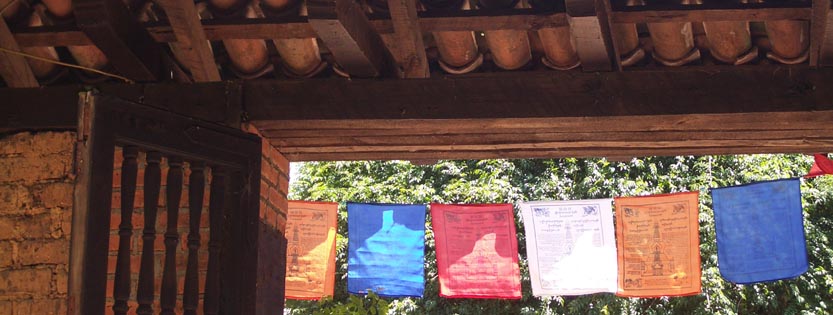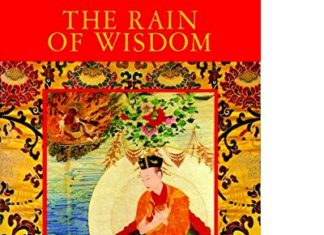
By Gary Hubiak
Acharya Simon Luna was re-visiting the homeland of his Mexican parents for the first time in 30 years in May of 2007. He had come to teach mahamudra at Shambhalacalli, the Shambhala Center in Tepoztlan, Mexico. When I asked him if he wanted to go visit Casa Werma before he left Mexico and he said, “Definitely!”. So, off we went in late May from Tepoztlan, on a 5 hour driving pilgrimage to Casa Werma.
It was the first visit for all 3 of us: Simon, myself and my wife Geo Legorreta. When we arrived, we were ushered through big red double doors, a portal really, into a huge, lushly landscaped piece of land hidden behind a total square block of adobe walls…from a busy village suddenly into a quiet, beautiful “mountain tropical forest”.
Patzcuaro is at 7,200 feet altitude, but so far south that ferns and orchids grow abundantly under the trees. Casa Werma is the largest single property in the entire town. It used to be a cornfield outside of the town when it was purchased by a Dutchman in the 1950s. Later it was acquired by Roger and Louise Randolph. Now it has been engulfed, totally surrounded by the houses of the “pueblo magíco”, magic village, of Patzcuaro, a strongly indigenous Mexican town.
The Randolphs connected with Chögyam Trungpa Rinpoche in the 1970s, and invited him to use their house to vacation there when they were not using it. Trungpa Rinpoche and family and friends came to Mexico a number of times, the most notably in 1980 when he wrote the Werma Sadhana on a sun dappled day on the back patio.
Those of you who have been at our other centers when they were young and just starting know how rough and raw the energy can be for many years. Somehow, someway, Casa Werma is already a gentle lady.
It was dusk when we arrived in 2007, and it was magical, the sun was low, a water fountain was noisily cascading by the front door of a large dark wooden house, lush foliage, ferns growing to our right. A large ceramic horse rearing on its hind legs looked at us fiercely as we entered. We were finally at Casa Werma!
The next day, we wandered around the square block of land of Casa Werma, now heavily forested by trees, (some exotic and not native to Mexico. Someone was smuggling in seedlings!). No wonder the residents of Patzcuaro call this place “el bosque”, the forest. All they can see behind the adobe walls and from the hills in town is a large rectangle of green treetops sticking up, surrounded by the expanse of flat neighboring houses and cobblestone streets in every direction.
Rinpoche must have done something (!) while he was here, because, as I said, it is almost too amazingly gentle for such a young dharma center. Those of you who have been at our other centers when they were young and just starting know how rough and raw the energy can be for many years. Somehow, someway, Casa Werma is already a gentle lady. Foreigners can drop into this spot in the middle of a very heavily Catholic, indigenous town in another country and immediately feel comfortable. It is an island of natural beauty in the midst of a busy and sometimes noisy village and an island of kindness to Buddhist practitioners in a town where the mind of Catholicism rules completely and without question. Go figure! Maybe the local dralas simply like people practicing meditation?
During that first visit with Simon in 2007, the place was in rougher physical shape than now. But even then the gentle energy was already strong. At that time the only upkeep was a part time hired non-sangha person living in the support house. When we arrived it was clean, roofs not leaking like before, and the place was starting its revival. Now, under the guidance and hard work of Eve Halpern and Cristina Sandoval, Casa Werma is really returning to its former glory, and more. (It really helps that Cristina is a professional contractor and remodeler!). When you see their slide show of “Then and Now”, it’s amazing how much has happened so quickly, and really rather quietly.
Dr. Eva Wong was in Patzcuaro in January 2009 and she has big visions for the place, as you might expect. She has envisioned plans for a shrine room located in what is now the center of the very large garden, with walls that open during the warm seasons with separate kitchen, staff and dorm buildings. Also, a Rigden garden next to the shrine room with statues of the 4 dignities and the Rigden King. Presto. Relatively few buildings and we have a fully developed Shambhala dharma retreat center! So, the energy is tamed and ready to accept these expansions, as soon as the legal purchase is completed. Usually it’s the other way: practice a lot, work on the buildings, the roads, the water rights, have programs, practice a lot more, and then gradually the local deities are pacified.
Still, that is in the future. When we were there with Simon in 2007, we looked around and thought, where can we practice? The sun room, an empty solarium next to the master bedroom, was the obvious choice. So we put a cloth over a piece of furniture and there was our shrine room. This room, and same piece of furniture is still the shrine and shrine room, albeit with lots of repairs and lots of more improvements, and now more renovations will begin soon. We practiced the Werma Sadhana in Spanish to acknowledge the voice of this land, and later (after Geo left) we switched back to English, Simon’s and my native tongue. Since then I have been back to Casa Werma 4 or 5 times, witnessing the journey and transformation of this special place. The legal work was daunting, the Mexican bureaucratic process for transferring the title to Shambhala International has been a lot of work by Alex Halpern. Now all the legal roadblocks have been cleared, and the last hurdle is “just money” to pay the back taxes the government wants before transferring the title. A fund raising project is under way to finally complete the journey to have this special property legally under the umbrella of Shambhala International.
Another very special feature of Casa Werma is the very palpable presence of Trungpa Rinpoche. His personal energy is so vivid it’s a little spooky. Even with all the energy of a group retreat, his presence is still very strong. Now, try a retreat there alone sleeping in the bed Trungpa Rinpoche slept in while he wrote the Werma Sadhana! You are guaranteed to have interesting dreams. Simon slept in Trungpa Rinpoche’s bed when we were there, and I found him one night wandering fully awake and clothed in the early morning hours. He looked like he had been up all night talking to his beloved root guru.
Eve Halpern and Cristina Sandoval, the current directors, have evolved an interesting schedule that works well for group retreats. They provide breakfast, then we have our morning practice session, lunch (comida) is provided from local indigenous cooks, then of course the traditional rota (very light) and rest period. Meals gathered around on the patio where Rinpoche wrote the Werma Sadhana with your program friends is delightful. People often forget how intense the sun can get, so don’t forget sunscreen and hats. After the afternoon practice session, there is something special for dinner: it’s “out on the town.” Usually people go out in groups.
There are two main plazas in the center of town, less than 10 minutes walk from the front door of Casa Werma, with several local market places along the way, all unlike anything you might see in the U.S. Talk about vivid sense perceptions after sessions of practice. It’s choiceless. Outside of the comfortable walls of Casa Werma…It’s Mexico! So colorful, raw. So alive in such a unique and indigenous way. You realize afresh, “Oh yeah, that’s right, I am in a different culture and country.” The local indigenous tribe, the Tarascans, were so fierce the Aztecs were never able to conquer them until the Spanish came. These people are still here, in the majority still speaking their own pre-hispanic language: Purepecha. This has been their land for many centuries.
But what do you want for dinner? Want a nice sit down restaurant with international menu?…Got it 5 minutes away.
Want to eat outside on the patio overlooking the central plaza with margaritas while listening to roaming musicians? Got it.
Want to get tacos at a local stand around the corner? Got it.
Want “Atole de Grano”, a homemade corn stew made with anise that is a meal in a bowl made by two families working 10 hours a day, add as much chile as you dare? Got that too. Brave enough to try the street stands? Well … Recommended only for experienced veterans.
After dinner, often the program is not over, you might come back for another practice session, or a discussion group, or a talk, or maybe a night off with a fire in the fire pit on the patio.
Commonly, one session of a Werma retreat is going to a nearby archeological site for a lhasang where Trungpa Rinpoche also did a lhasang the day before he wrote the Werma Sadhana.
There is nothing like doing Werma practice in the place where it was born, group or individual retreat. But Shambhala Training, Shambhala Art and Movement programs are being offered as well. Keep your eye out. There will continue to be an expansion of the number and types of programs offered in this unique part of our mandala; the southern most extension of the Druk Sakyong’s Shambhala activity.
A student of the Vidhyadhara since 1973, Gary Hubiak lived at Tail of the Tiger as it became Karme Choling, and SMC when it was called Rocky Mountain Dharma Center. Gary practiced dentistry in Boulder for over 20 years, has 2 lovely daughters and is now Co-Director of the Shambhala Center in Tepoztlan, Mexico. He teaches Shambhala Training and practices a lot of Werma Sadhana.
















